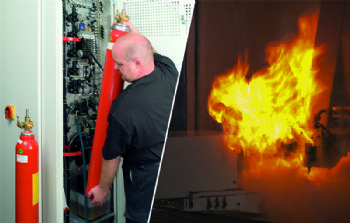
Many major machine tool companies — such as Index, Traub, Tornos, Walter, Ewag, Rollomatic and Reishauer — fit fire-prevention systems as standard; and every year Kraft & Bauer UK retrofits its own systems to a wide variety of machines.
Chris Boraston, managing director of the Coventry-based company (
www.kraftandbauer.co.uk), says the consensus regarding the risk of fire is that any machine which uses oil, machines a self-combustible material (such as titanium or magnesium alloys) or produces a spark poses a direct risk of fire and this must be protected.
“Besides injuries to persons, the consequences to engineering companies following a machine tool fire can be significant, with lengthy production stoppages even leading to insolvency.
“Moreover, many engineering companies think that insurance is sufficient, but unless annual service certificates for the fire systems can be provided, any insurance policy is likely to be invalid; and even if a claim were to be settled without delay, it could take many months before factories and machines were replaced.
“Employers have the duty to determine, within the framework of a risk assessment, if fires or explosions on machines are possible; and when purchasing any machine tool they should first ensure that the machine is compatible with the metal-working fluids intended to be used.
“Most incidents are connected with the generation of incandescent chips, high-energy sparks or hot surfaces acting as ignition sources. Root causes included broken or worn milling cutters, drills and turning inserts — plus sparks from grinding processes.
“In the immediate vicinity of the machining zone a reactive mixture of metal-working fluids and air is formed, which may be ignited by the ignition sources mentioned.
“Any fire propagates very quickly through the whole interior of the machine tool, and flame ejections may occur through a variety of gaps in the machine enclosure — such as openings for swarf removal.”
The legal requirement for fire protection is that if a machine is run automatically, an automatic system must be used; if a machine can only ever be ran manually then a manually activated system is acceptable.
However, in both cases the system must be fully integrated within the machine tool itself; having hand-held or externally used systems is not acceptable.
“It also has to be ensured that a fire is detected as early as possible, and that the fire-extinguishing system is activated without delay.
“For automatic activation of an extinguishing system, thermal heat detection is used in conjunction with optical fire detection — either infra-red or ultra violet light systems.
“These are placed within the machine and at other places, where fire hazards exist, such as mist extraction systems, chip conveyors and tool changers. The sensors are linked to both optical alarms and acoustic alarms; the latter must be at least 5dB louder than the background noise, to alert operators to the fire incident and to warn them to vacate the area.
“Machine tools must be tested for fire safety prior to initial commissioning, and at least annually after that —plus after any maintenance work that might affect safety. The person carrying out the routine checks must be a ‘competent person’ and records have to be kept.”
Under the latest legislation, a ‘nominated person’ must carry out a fire-risk assessment and ensure that any fire precautions that the assessment recommends are implemented.
Not complying with the new regulations can result in anything from a fine of £5,000 in a magistrate’s court up to an unlimited fine and/or two years in prison if the case is held in the high court.
Enforcement of these new regulations is carried out by the local fire authority, whichappoints inspectors to enter premises to inspect records and ensure that compliance with the new regulations is being made.
In conclusion, Mr Boraston said: “Anyone who thinks ‘the company’ will foot the bill in the case of an issue is sadly mistaken, as in practice the health and safety officer, factory manager, head of maintenance or the owner/directors will more than likely be held personally responsible.
“Checks on the correct functioning of the extinguishing system will generally be carried out within the framework of servicing and maintenance requirements undertaken by the company that installed the system, with the results of the test recorded in a test book or a test report.
“These should ideally be stored over the whole operational lifetime of the extinguishing system, but no less than four years.”